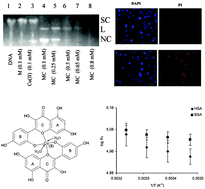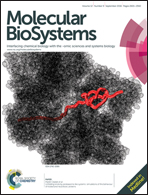Cell cytotoxicity and serum albumin binding capacity of the morin–Cu(ii) complex and its effect on deoxyribonucleic acid†
Abstract
The dietary components, flavonoids, are important for their anti-oxidant properties and the ability to act as metal ion chelators. The characterization of the morin–Cu(II) complex is executed using elemental analysis, FTIR and mass spectroscopy. DNA cleaving and cell cytotoxicity properties followed by serum albumin binding have been investigated in this report. The morin–Cu(II) complex was found to cleave plasmid pBR322 DNA via an oxidative pathway as revealed by agarose gel based assay performed in the presence of some scavengers and reactive oxygen species. The breaking of the deoxyribose ring of calf thymus DNA (ct-DNA) was also confirmed by the formation of thiobarbituric acid reacting species (TBARS) between thiobarbituric acid and malonaldehyde. The morin–Cu(II) complex is able to inhibit the growth of human HeLa cells. Fluorescence studies revealed that the morin–Cu(II) complex can quench the intrinsic fluorescence of serum albumins (SAs) via a static quenching method. The binding constants were found to be in the order of 105 M−1 and observed to increase with temperature. Both ΔH° and ΔS° are positive for the binding of the morin–Cu(II) complex with serum albumins which indicated the presence of hydrophobic forces. Site-selectivity studies reveal that the morin–Cu(II) complex binds to both site 1 (subdomain IIA) and site 2 (subdomain IIIA) of human serum albumin (HSA) and bovine serum albumin (BSA). Circular dichroism (CD) studies showed the structural perturbation of SAs during binding with the morin–Cu(II) complex. The results from binding studies confirmed that after complexation with the Cu(II) ion, morin alters its mode of interaction with SAs which could have differential implications on its other biological and pharmaceutical properties.

- This article is part of the themed collection: Chemical Biology in Molecular BioSystems

 Please wait while we load your content...
Please wait while we load your content...